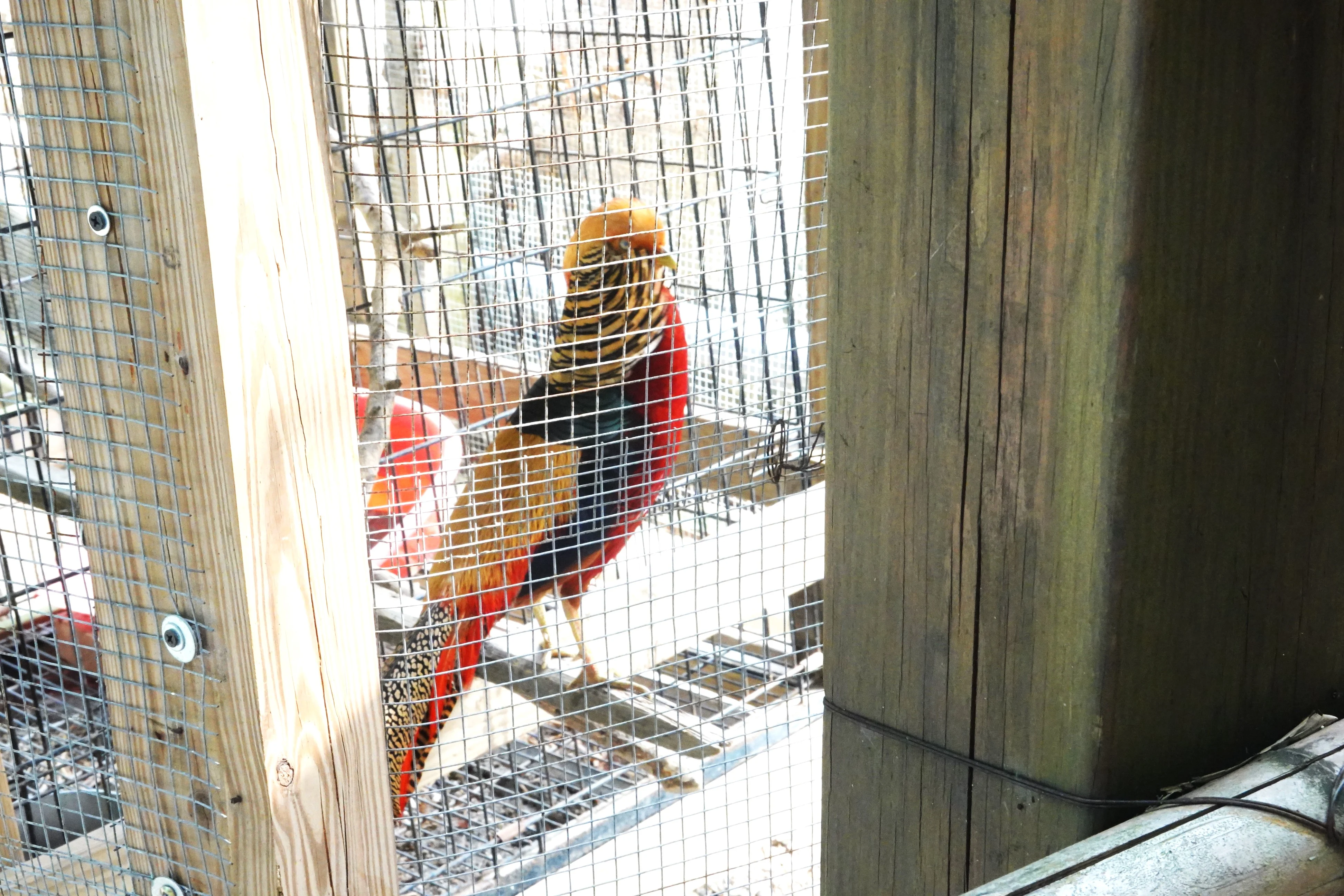The golden pheasant, also known as the Chinese pheasant, and rainbow pheasant, is a gamebird of the order Galliformes (gallinaceous birds) and the family Phasianidae (pheasants). The genus name is from Ancient Greek khrusolophos, "with golden crest", and pictus is Latin for "painted" from pingere, "to paint". The males are particularly striking with a golden crest and rump, a bright red body, and orange ‘cape’. Females are less colorful but with a longer tail and a buff face and throat. The golden pheasant is native to forests in mountainous areas of western China. However, because of its beautiful appearance, it was introduced to European countries such as Britain and France in the 19th century. Because of its strong fecundity and unpalatable meat, the activity range of the wild Golden Pheasant expanded rapidly, and eventually it was distributed in large numbers across the Eurasian continent today, becoming a very common wild animal. Golden pheasants feed on the ground on grain, leaves and invertebrates, but they roost in trees at night. During winter, flocks tend to forage close to human settlements at the edge of forest, taking primarily wheat leaves and seeds. While they can fly clumsily in short bursts, they prefer to run and spend most of their time on the ground. The male Golden Pheasant emits a metallic call during the breeding season, which is part of its courtship display. The golden pheasant is wary and timid. Hearing and vision are sensitive, and it will immediately run away at the slightest sound. Illegal hunting is the greatest threat to wild populations of this species. The beautiful appearance of the male golden pheasant makes it a keen target of poachers. Because of its bright feathers, the skin of the male bird can be exported for decoration, and the live bird can be used for viewing and exhibition. The number of birds killed from various production areas every year is quite alarming. In 2021, the golden pheasant was included in the list of China's national key protected wild animals (2021) and is a national second-level protected animal. The IUCN Red List classifies the Golden Pheasant as Least Concern, indicating that it currently faces no significant threats to its survival.
紅腹錦雞,又稱金雞、彆雉、山雞、采雞,是雞形目、雉科的鳥類。這個屬名源自古希臘語 khrusolophos,為「有金色冠」的意思,pictus 是拉丁語,為「繪畫般的」的意思,源自 pingere,意為「繪畫」。雄性有引人注目的金色冠和尾部、鮮紅色的身體和橙色的「披肩」。雌性顏色暗淡,但尾巴較長,臉和喉嚨呈淺黃色。紅腹錦雞為中國特有鳥種,分布在中國中部和西部的青海西南部地區、甘肅和陝西南部、四川、湖北、雲南、貴州、湖南及廣西等地。但因為外形美麗而在19世紀時引入至英國、法國等歐洲國家。又因其繁殖力強、肉質不可口,導致野生的紅腹錦雞的活動範圍迅速擴散,最終大量分佈至現今的歐亞大陸之中,成為一類非常常見的野生鳥類。紅腹錦雞以地上的穀物、樹葉和無脊椎動物為食,但夜間棲息在樹上。冬季它們常在森林邊靠近人類住區的地方覓食,主要以小麥葉和種子為食。雖然它們可以很快加速笨拙地飛行,但它們比較喜歡奔跑,大部分時間是在地面上活動。雄性紅腹錦雞在繁殖季節會發出金屬般的叫聲,這是其求愛表現的一部分。紅腹錦雞性機警,膽怯怕人。聽覺和視覺敏鋭,稍有聲響,立刻逃遁。非法捕獵是對該物種野生種羣的最大威脅。雄性紅腹錦雞美麗的外表使得它成為偷獵者熱衷的目標,因其羽色豔麗,雄鳥皮張可外銷供裝飾用,活鳥供觀賞展出用,每年從各產地捕殺數量相當驚人。2021年,紅腹錦雞被列入中國國家重點保護野生動物名錄(2021年),為國家二級保護動物。






Notes 筆記
- The golden pheasant, also known as the Chinese pheasant, and rainbow pheasant, is a gamebird of the order Galliformes (gallinaceous birds) and the family Phasianidae (pheasants). The genus name is from Ancient Greek khrusolophos, "with golden crest", and pictus is Latin for "painted" from pingere, "to paint".
- The adult male’s coloration is characterized by a golden crest and rump, a bright red body, and orange ‘cape’. Their face is a contrasting rusty tan, and they have a bright yellow eye with a black pupil. The green upper back transitions to a golden-yellow on the lower back and rump. Females are less colorful but with a longer tail and a buff face and throat.
- The golden pheasant is native to forests in mountainous areas of western China. However, because of its beautiful appearance, it was introduced to European countries such as Britain and France in the 19th century. Because of its strong fecundity and unpalatable meat, the activity range of the wild Golden Pheasant expanded rapidly, and eventually it was distributed in large numbers across the Eurasian continent today, becoming a very common wild animal.
- Golden pheasants feed on the ground on grain, leaves and invertebrates, but they roost in trees at night. During winter, flocks tend to forage close to human settlements at the edge of forest, taking primarily wheat leaves and seeds.
- While they can fly clumsily in short bursts, they prefer to run and spend most of their time on the ground.
- The male Golden Pheasant emits a metallic call during the breeding season, which is part of its courtship display.
- The golden pheasant is wary and timid. Hearing and vision are sensitive, and it will immediately run away at the slightest sound.
- Illegal hunting is the greatest threat to wild populations of this species. The beautiful appearance of the male golden pheasant makes it a keen target of poachers. Because of its bright feathers, the skin of the male bird can be exported for decoration, and the live bird can be used for viewing and exhibition. The number of birds killed from various production areas every year is quite alarming. In 2021, the golden pheasant was included in the list of China's national key protected wild animals (2021) and is a national second-level protected animal. The IUCN Red List classifies the Golden Pheasant as Least Concern, indicating that it currently faces no significant threats to its survival.
- 紅腹錦雞,又稱金雞、彆雉、山雞、采雞,是雞形目、雉科的鳥類。這個屬名源自古希臘語 khrusolophos,為「有金色冠」的意思,pictus 是拉丁語,為「繪畫般的」的意思,源自 pingere,意為「繪畫」。
- 成年雄性紅腹錦雞有金色的冠和尾部、鮮紅色的身體和橙色的「披肩」。它們的臉是截然不同的赭色,眼睛為亮黃色,瞳孔為黑色。綠色的上背轉變成金黃色的下背部和尾部。雌性顏色暗淡,但尾巴較長,臉和喉嚨呈淺黃色。
- 紅腹錦雞為中國特有鳥種,分布在中國中部和西部的青海西南部地區、甘肅和陝西南部、四川、湖北、雲南、貴州、湖南及廣西等地。但因為外形美麗而在19世紀時引入至英國、法國等歐洲國家。又因其繁殖力強、肉質不可口,導致野生的紅腹錦雞的活動範圍迅速擴散,最終大量分佈至現今的歐亞大陸之中,成為一類非常常見的野生鳥類。
- 紅腹錦雞以地上的穀物、樹葉和無脊椎動物為食,但夜間棲息在樹上。冬季它們常在森林邊靠近人類住區的地方覓食,主要以小麥葉和種子為食。
- 雖然它們可以很快加速笨拙地飛行,但它們比較喜歡奔跑,大部分時間是在地面上活動。
- 雄性紅腹錦雞在繁殖季節會發出金屬般的叫聲,這是其求愛表現的一部分。
- 紅腹錦雞性機警,膽怯怕人。聽覺和視覺敏鋭,稍有聲響,立刻逃遁。
- 非法捕獵是對該物種野生種羣的最大威脅。雄性紅腹錦雞美麗的外表使得它成為偷獵者熱衷的目標,因其羽色豔麗,雄鳥皮張可外銷供裝飾用,活鳥供觀賞展出用,每年從各產地捕殺數量相當驚人。2021年,紅腹錦雞被列入中國國家重點保護野生動物名錄(2021年),為國家二級保護動物。世界自然保護聯盟紅色名錄將紅腹錦雞列為無危物種,顯示它目前的生存沒有面臨重大威脅。
References 參考資料
- Wikipedia: Golden pheasant
- BIRDA: Golden Pheasant
- 維基百科: 紅腹錦雞
- 百度百科: 紅腹錦雞
Birds Posts 鳥的帖子
Comments